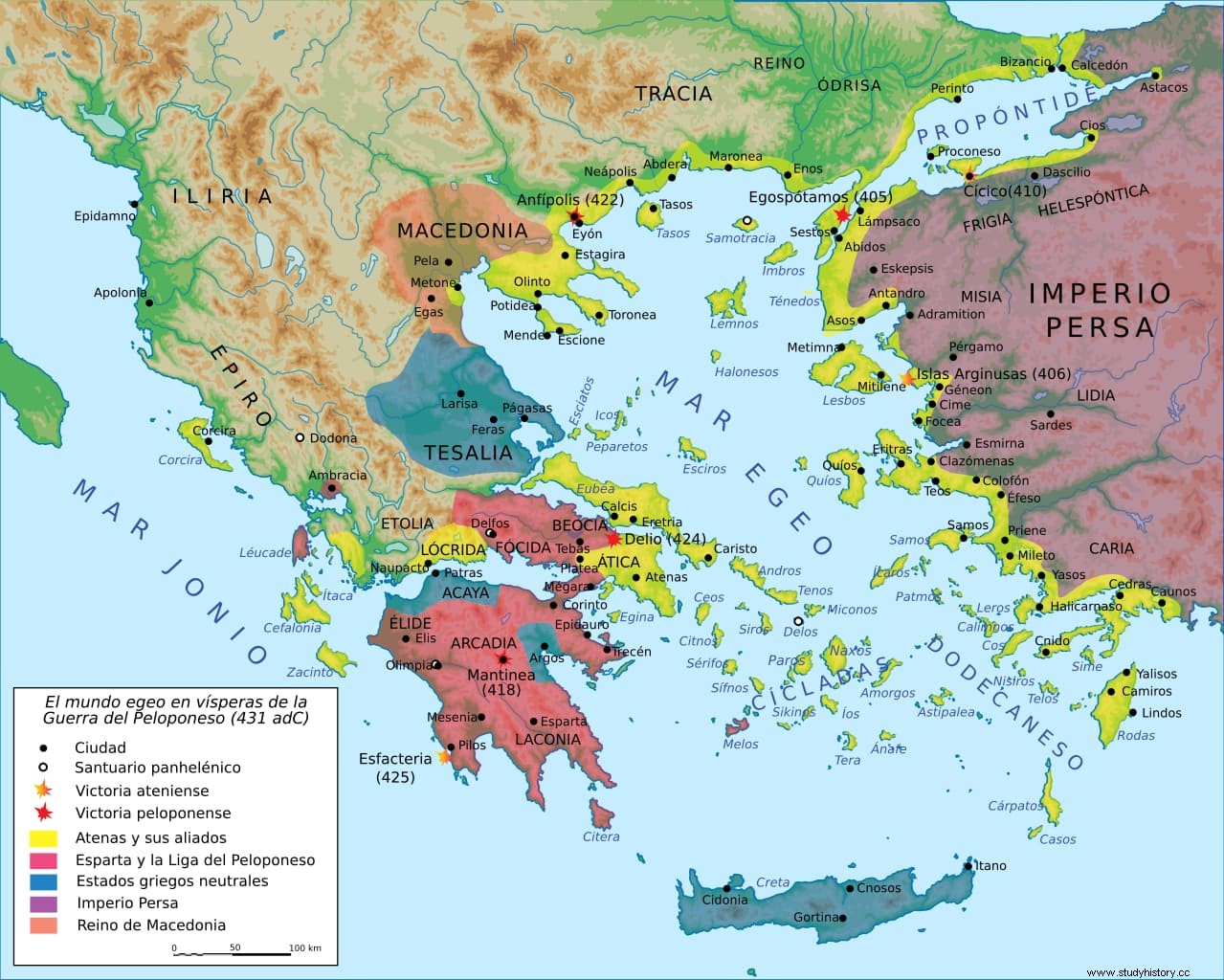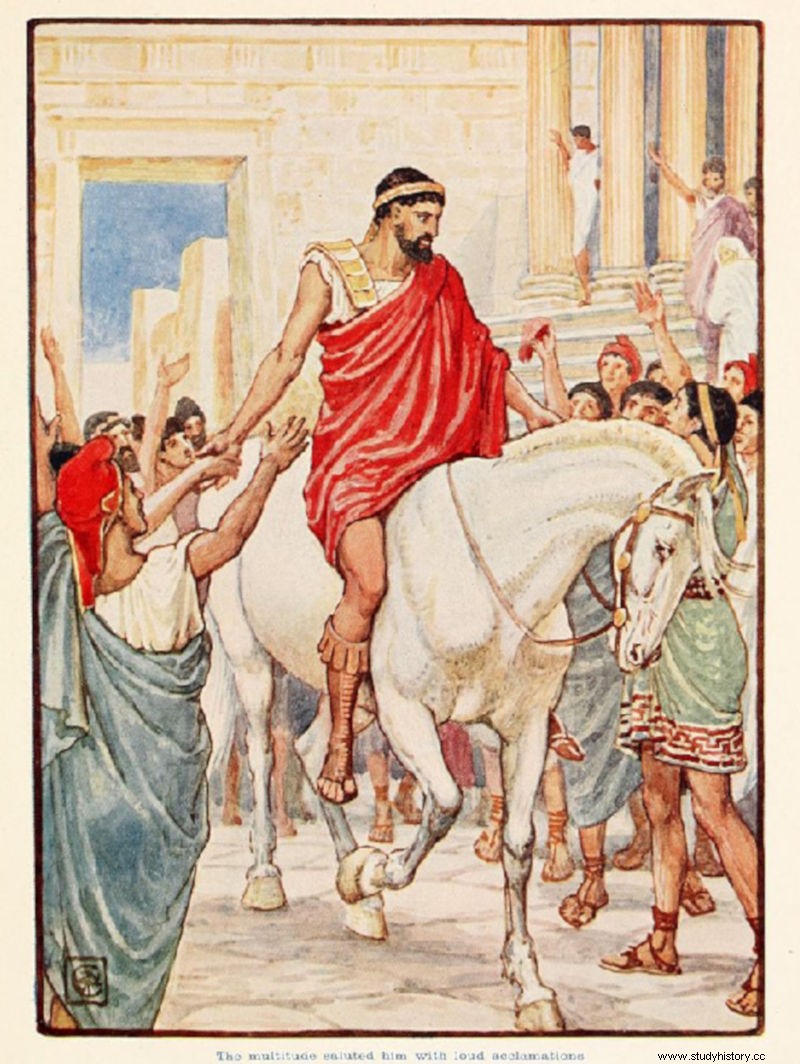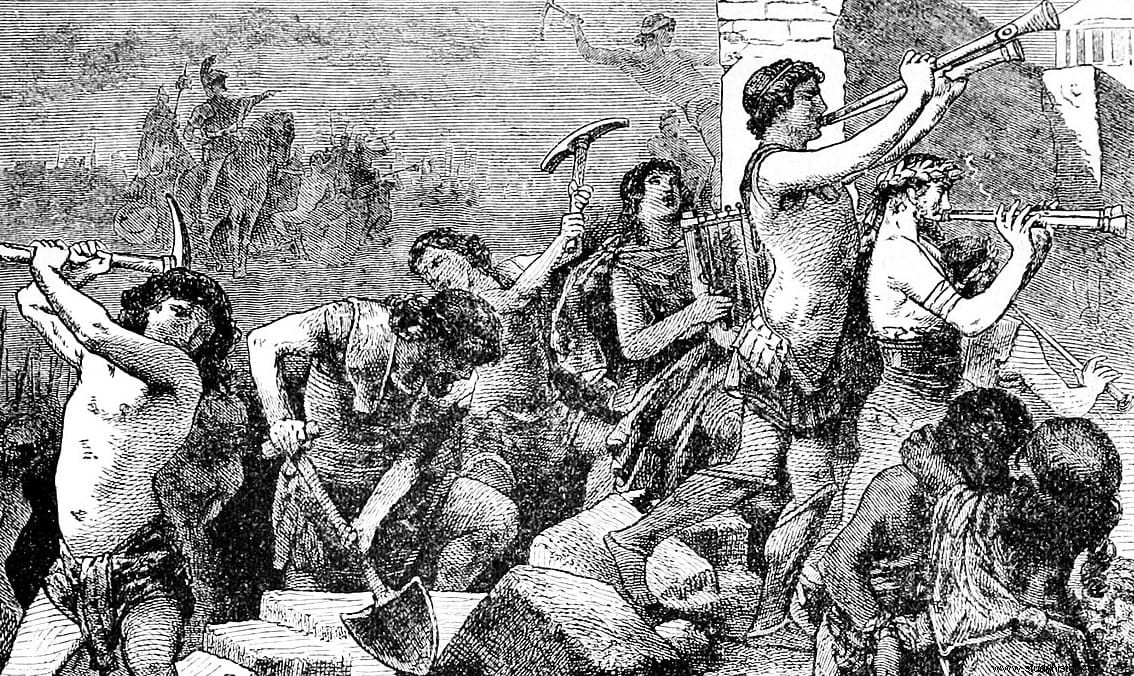Traditionally, the great trump card of Athens over Sparta in that long rivalry they maintained for primacy in the Greek world was their navy, thanks to which they were able to compensate for the unstoppable war machine of the Spartan army on land. However, after the trial for blasphemy of his most prominent sailor, Alcibiades, who went over to the other side to avoid his conviction, that situation was balanced and in the year 405 B.C. the fleet of the navarca Lysander managed to turn around the Athenian superiority, prevailing brilliantly and overwhelmingly in the amphibious battle of Aegospotami. It was the beginning of the end of the Peloponnesian War.
That contest had already lasted more than a quarter of a century, since it had begun in 431 B.C. when confronting the Attic-Delic League, led by Athens, with that of the Peloponnese, led by Sparta. Throughout those two and a half decades, hostilities alternated with periods of truce, so that the classic periodization identifies a first phase, known as the Archidamic War (in which the Athenian ships managed to frustrate the repeated enemy invasion attempts), a Five years of tranquility agreed upon in the Peace of Nicias, a second phase favorable to the Spartans thanks to their triumphs in Mantinea and Syracuse, and a final episode known as the Decelia War, in whose context the battle of Aegospotami was framed.
The Decelia War, also called the Ionia War because it was in this Greek region of Asia Minor where the operations took place, began when the Athenian thalassocracy entered into crisis, financially and materially ruined after the disaster in Sicily. In fact, it was also a serious human loss, not only in lives but in command, since the four strategos who led the campaign on the Italian island ended badly (Alcibiades, as we saw, joining the Spartans; Demosthenes and Nicias, summarily executed; Lamachus, fallen in combat). And, likewise, the politics of Athens suffered a shock that led to the replacement of its system of government of ten probuloi (elders), five proedroi (presidents) and one hundred citizens to the detriment of the Boulé (Council of Five Hundred), which in practice meant the transition from a democracy to an oligarchy.

Sparta was grown up, optimistic and convinced that final victory was within reach. As a result of this attitude, and with the advice of Alcibiades, King Agis II had launched a new invasion of Attica, occupying in 413 B.C. the city of Decelia, strategically very important because its location between Boeotia and Athens was essential to interrupt supplies to it. Knowing this, the Spartans built a fort on top of a gorge and thus began to strangle the Athenian economy, especially by cutting off the flow of silver being shipped from the Laurion mines.
In addition, from that base they made incursions through various localities that allowed them to seize all their cattle and favor the escape of the nearly twenty thousand slaves that their enemies had. Athens had to switch to supplies by sea, which was more expensive and difficult, not to mention the affront of having the hated rival settled in her own territory. However, she still trusted her fleet, which even when depleted was always a risk to Sparta; That is why Agis II opened negotiations with Tissaphernes and Pharnabazo II, Persian satraps of Sardes and Dascilio, despite the fact that, theoretically, Sparta and the Achaemenid Empire were still at war (in 449 BC the Persians signed the Peace of Callias only with Athens) .

Dario II suffered from internal problems, with an attempted coup by Amorges, the satrap of Lydia, who was supported by the Athenians promoting the rebellion in the Caria region. This convinced the king to help Agis II; he could not provide many troops but money, in exchange for his new ally giving up the Greek cities of Asia Minor, which were mostly pro-Athens anyway. In this way, revolts were encouraged in those cities that, effectively, began to change sides:Chios, Lesbos, Euboea, Miletus, Methymna, Eritrea, Lebedos, Mytilene, Teos and Clazomena turned their backs on their former partner, at whose side only Samos.
Meanwhile, Alcibiades had been playing two decks. He knew that, despite everything, he was distrusted in Sparta, so he made contact with the Athenian oligarchy in support of his rise to power in 411 BC. But the city had polarized between moderates and extremists; as these last ones planned to agree with Sparta, they were persecuted and separated. In this way, a mixed regime was established that ended up giving way to a restoration of democracy in 410 BC. Cleofon led it, radically opposed to any negotiation with the enemy. Differences would have to be settled on the battlefield, and Alcibiades was too valuable a piece to be neglected.
In 410 BC, under pressure from the army, he was restored to his position as navarch of the fleet. He did not arrive in time for the clashes of Cynosema and Abydos, in which the Athenian ships prevailed over the Peloponnesians, but he did for Cyzicus where he won a great victory capturing all the enemy ships that were not destroyed. Sparta requested peace, but Athens looked strong now and rejected the proposal. And, in fact, shortly after he claimed new triumphs in Chalcedon, Selimbria and Byzantium, which gave him control of the Hellespont again and allowed him to reestablish his supply routes.

In 407 BC, Alcibiades returned to his city, where he was enthusiastically received, the old charges against him were dismissed, and his property was restored to him. But the superstitious had reasons for pessimism:his return coincided with the celebration of the Plintheria (a festival in honor of Athena), a day considered disastrous, and the bad omen was fulfilled the following year, when he was resoundingly defeated at Notio . That meant harsh criticism and the replacement by Conón, choosing then to go into exile; he never returned and it is possible that this was the first big mistake that would lead to the final condemnation of Athens.
Because another military genius had emerged opposite. He was called Lysander, a member of the Heraclid dynasty, prestigious but poor and, therefore, without access to power (in fact, some assume him to be an ascended helot). His appointment as navarch of the Peloponnesian fleet was his first merit known to him and he more than fulfilled it by defeating Alcibiades but his mandate ended there and he was replaced by Callicratidas; Lysander did not take it well and returned to Cyrus, the son of Darius II, whose friendship he had earned, the money he had given him to expand the fleet. However, Callicratidas also showed great competence in 406 BC, blockading Conon's ships at Mytilene.
Everything looked good for Sparta, especially taking into account that the triremes that Athens sent to help Conon were newly built and manned by inexperienced sailors; it was a fleet of a hundred and a half ships for whose financing it was necessary to decree new taxes on allies and merchants, as well as to melt down the treasure of the Acropolis. Confident, Callicratidas left fifty of his own blockading Mytilene and left with the rest (about a hundred and twenty) to meet the Athenians. They engaged in combat at Arginusas, south of Lesbos, and surprisingly, Conon was able to break through the blockade by joining the others for victory. The Spartan disaster was of such caliber that only a storm prevented it from losing all its troops, although Calicratidas died.

A brilliant triumph that even allowed Athens the frivolity of convicting and executing several captains who failed to pick up their shipwrecks (including the son of Pericles), depriving her of some of her most capable sailors, and returned things to their original state. :with the city that owns the Aegean and refusing to accept the peace requests of the enemy. This was amended by heeding Ciro's suggestion to rename Lysander navarca. He couldn't do it de iure , since the law prevented him from occupying the position twice in a row, but it was solved by putting him as second to a straw man, Araco. With his appointment, Persia agreed to send new batches of money that allowed triremes to be purchased to replace the lost ones. And in 405 BC, the fleet laid siege to Lampsacus, in the Hellespont, with the aim of once again interrupting Athenian maritime traffic.
Conon's ships went for him but, having no available ports near Lampsacus, which had already fallen, they anchored on a neighboring beach where the Aegospotami River emptied. Every day, for five days, they went out looking for a fight but Lisandro eluded her; as they did not have the capacity to attack him in his refuge, they ended up weighing anchor and leaving. Interestingly, according to Xenophon in his Helenica, Alcibiades lived in the surroundings and gave some advice to the Athenian commanders, recommending the port of Sesto because it guaranteed them food and offering them the alliance of the Thracians if they allowed him to share command; he was not listened to in what was perhaps the second big mistake with that character.
The Athenian fleet was at Aegospotami when Conon resolved to go out to sea once more, albeit by ordering a squadron of thirty ships, commanded by Philokles, to advance as bait to lure the Spartans. According to Diodorus of Sicily, Lysander accepted the challenge but did so so quickly and efficiently that he caught up with that advance party and destroyed it before the rest of Conon's triremes could even set sail, stranded on the sand. Trapped on the beach, the Athenians were swept away. Xenophon gives a slightly different view by telling that Lysander fell upon them after another day without a fight, when they landed and spread out for provisions.
Whichever version is correct, Conon suffered a catastrophic defeat, losing some three thousand men and most of his ships. He himself had to hurriedly escape with only nine ships and take refuge in Cyprus. Lysander's lightning maneuver led to rumors that he had spies or traitors, joining a command called Adeimanto because he was the only one the Spartans did not execute (in revenge for a similar earlier Athenian action); the oligarchic party of Athens, interested in a defeat to create discontent and regain power, was also accused. And the fact is that, without a fleet, the city was left defenseless.

The Peloponnesian fleet advanced unopposed, being welcomed by Byzantium and Chalcedon; only Samos resisted, so it was besieged. Meanwhile, news of the naval cataclysm reached Athens, which prepared to resist a siege as well. It was surprising that Lysander granted the Athenian garrisons a safe conduct to return to their city, but he obeyed a Machiavellian plan:the more people took refuge behind his walls, the less food there would be for everyone as the supply routes by sea and land were blocked. And so it was.
In 404 BC, when the famine became acute, the people rose up against their rulers. Cleofon was assassinated and the conditions of surrender were accepted, which included the demolition of the fortifications of Piraeus and the Long Walls that linked it with the urban center; Likewise, Athens had to hand over its fleet while keeping only a dozen ships, cede its foreign possessions without excepting the cleruchies (a colonial modality), allow the return of exiles and join the Peloponnesian League under the leadership of Sparta (which, however, , did not give in to Corinthian pressure to raze the city).
The regime of the Thirty Tyrants was also imposed, a despotic pro-Spartan oligarchy under the leadership of Critias that guaranteed the Lacedaemonian supremacy in the Hellenic world. Xenophon summed it all up poetically:
